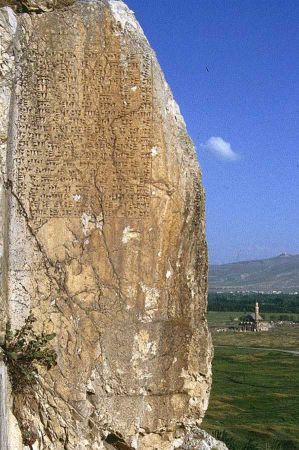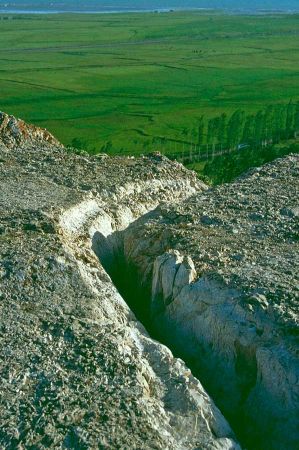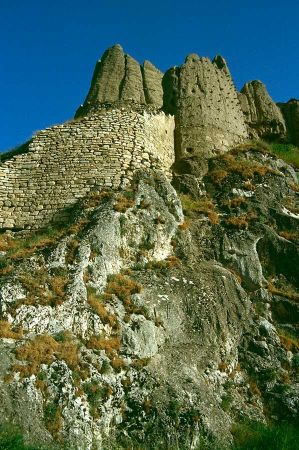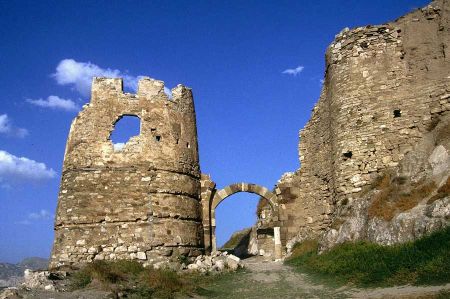Van / Tušpa - capital of the Urartian Empire
- Written by Portal Editor
If you only deal a little with the history of the city of Van, you will also find a very long history that can be traced back to around 5,000 BC. The first traces of human settlement can be found on the Tilkitepehügel (fox hill) in the vicinity of the town Van.
Around 3,000 BC there were the first large settlements of people who mainly used the lake and its surroundings as hunters and thus as a source of food. Around 1,000 BC there was already a city-like character, which led to Tušpa / Tuschpa, as Van was called at that time, being designated the capital.
The origin of the Urartu people is still disputed today, it was probably tribal groups of shepherds from the east who settled here. In the 9th century BC Tušpa became the capital of the Kingdom of Urartu, which also involved the construction of a fortress near the Van Fortress, which still exists today. In the years from 834 - 828 BC, King Sarduri I of the fortress ruled the country around which the actual city of Tušpa was formed. All future rulers of the Urartu always had the additional title "Ruler of the city of Tušpa", which suggests the relatively loose settlement of the region. Tušpa is first mentioned in an inscription by the neighboring Assyrian king Šulmanu-ašared III (858 - 824 BC) which tells of a victory in a battle with King Sarduri.
The territory of Urartu is expanding
 In addition to the Assyrians, the tribes or states of the Manneans in the southeast, the Cimmerians and Scythians in the north and the Assyrians in the south were among the neighboring peoples of the Urartu. Military campaigns were able to extend the Urartu's sphere of influence to the Euphrates arch to the south and the settlement of Qulha in the northwest. For a time Lake Sevan and the Araxestal in the north as well as Lake Urmia and Rawanduz in the southeast belonged to the territory of the Urartu. Scientific research today assumes that King Išpuini or his son Menua was able to conquer Hasanlu around 810 BC. The campaigns of King Išpuini reached the southern and western ends of Urmia Lake, as can be seen from the inscriptions found in Taštepe and Karagündüz. In some cases, the current border with Georgia was even reached.
In addition to the Assyrians, the tribes or states of the Manneans in the southeast, the Cimmerians and Scythians in the north and the Assyrians in the south were among the neighboring peoples of the Urartu. Military campaigns were able to extend the Urartu's sphere of influence to the Euphrates arch to the south and the settlement of Qulha in the northwest. For a time Lake Sevan and the Araxestal in the north as well as Lake Urmia and Rawanduz in the southeast belonged to the territory of the Urartu. Scientific research today assumes that King Išpuini or his son Menua was able to conquer Hasanlu around 810 BC. The campaigns of King Išpuini reached the southern and western ends of Urmia Lake, as can be seen from the inscriptions found in Taštepe and Karagündüz. In some cases, the current border with Georgia was even reached.
After the costly wars against the Cimmerians, the Assyrians and the Scythians, the Kingdom of Urartu lost more and more of its importance, which can also be seen in the capital Tušpa. In the 6th century, the kingdom was doomed to insignificance and the city gradually lost its inhabitants. The Zidadelle, on the southern side of which there is still a clearly recognizable inscription of the Persian king Xerxes I, was abandoned. According to Armenian tradition, the remains of the fortress, still visible today, are said to have been built as an impregnable fortress by the Persian queen Semiramis. Now the name of the city was changed to Van and Van was part of the Persian Empire
For the new rulers as well as for later rulers, the Urartian tombs were the works of mystical figures such as Artases and Gregor Narekac'i. According to Armenian mythology, King Artaxias is said to have lived in one of the rock caves from where he could overlook Lake Van. Another mystic from the kingdom of Vaspurakan, Saint Gregorius von Narek (951-1003) is said to have often used these caves for his prayers and probably wrote at least parts of his writings "Book of Lamentations" here.
Only Alexander the Great was able to conquer Van and the fortress through conquest and victory over the Persians in 331 BC. After his death, an eventful history began, which led from belonging to the Seleucid Empire, belonging to the Kingdom of Armenia in the 2nd century BC to the Ottomans.
Ottomans and Safavids in conflict over Tušpa
 Van and with it Armenia now often got caught between the fronts. First it was Rome and the Parthians, later Byzantium and the Sassanids, then in the 7th century Muslim Arabs conquered the region. Then it was again the Armenian principalities, with Vaspurakan at the head, who seized power. With the invasion of the Seljuks, Van fell under their rule. Around 1240 the Mongols conquered the region around Van, in the 14th century it belonged to the Timurid Empire. Conflicts between the Ottomans and the Safavids brought further changes in rulership, for example Van was conquered by the Safavids in 1502, recaptured by the Ottomans in 1515 and again passed to the Safavids in 1520. Van was finally conquered by the Ottomans on August 25, 1548 and assigned to the empire as an independent Ottoman Eyalet.
Van and with it Armenia now often got caught between the fronts. First it was Rome and the Parthians, later Byzantium and the Sassanids, then in the 7th century Muslim Arabs conquered the region. Then it was again the Armenian principalities, with Vaspurakan at the head, who seized power. With the invasion of the Seljuks, Van fell under their rule. Around 1240 the Mongols conquered the region around Van, in the 14th century it belonged to the Timurid Empire. Conflicts between the Ottomans and the Safavids brought further changes in rulership, for example Van was conquered by the Safavids in 1502, recaptured by the Ottomans in 1515 and again passed to the Safavids in 1520. Van was finally conquered by the Ottomans on August 25, 1548 and assigned to the empire as an independent Ottoman Eyalet.
The story became tragic in the second year of the First World War when large parts of the Armenian population Vans supported the armed forces of the Russian Empire, coming from the Caucasus, and were thus able to take the city on May 20, 1915. As early as April 7, 1915, the city had been surrounded by around 10,000 Armenian rebels, whereupon large parts of the Muslim population tried to flee the city of Van. People from the surrounding villages such as Derebey, Hakis, Zorova, Hidir, Göllü, Seyhane and Seyhkara also tried to flee to Zeve, a central village. Zeve was then stormed by the Armenian rebels, with about 2,000 Muslim civilian casualties. A little later the Ottoman army succeeded in retaking, but a little later the Russians were victorious again.
 It was only with the withdrawal of the Russians due to the October Revolution that Van came back to the Ottomans. Due to the defeat in the First World War, it was decided in the Treaty of Sèvres to form an independent Armenia in the east of the former Ottoman Empire. In 1920, however, these regulations were destroyed again by the Turkish Wars of Liberation (Kuvayı Milliye) and Van was recaptured by the Armenians. Large parts of the Armenian population have now been decimated through expulsion and murder, which has led to considerable tensions between Turkish and Armenian interest groups to this day, despite the provisions in the 1921 Treaty in Kars and a little later in the Lausanne Treaty (1923) in which about the A new border line was decided until today this border line is not recognized by the Armenian side.
It was only with the withdrawal of the Russians due to the October Revolution that Van came back to the Ottomans. Due to the defeat in the First World War, it was decided in the Treaty of Sèvres to form an independent Armenia in the east of the former Ottoman Empire. In 1920, however, these regulations were destroyed again by the Turkish Wars of Liberation (Kuvayı Milliye) and Van was recaptured by the Armenians. Large parts of the Armenian population have now been decimated through expulsion and murder, which has led to considerable tensions between Turkish and Armenian interest groups to this day, despite the provisions in the 1921 Treaty in Kars and a little later in the Lausanne Treaty (1923) in which about the A new border line was decided until today this border line is not recognized by the Armenian side.
During the fighting in 1915, the city of Van was so badly damaged that reconstruction began a few kilometres away. Another fate befell Van in 1950 when a major earthquake destroyed large parts of the city.
Please also read:
Herakleia Lynkestis - a day trip to Bitola
Camping site Kleinwalsertal - Käfer on a big tour
